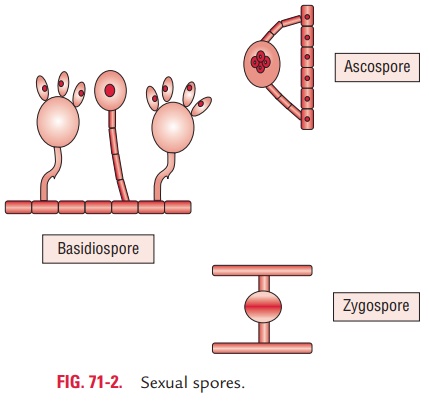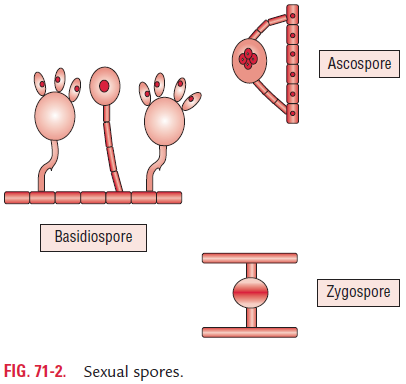Chapter: Microbiology and Immunology: Mycology, Fungi: Introduction to Mycology
Reproduction of Fungi

Reproduction of Fungi
Fungi can reproduce sexually by forming sexual spores and asexually by forming conidia or asexual spores.
Sexual spores are of three types: zygospores, ascospores, and basidiospores (Fig. 71-2). Ascospores are formed in a sac called ascus,whereas basidiospores are formed outside on the tip of a pedestal called a basidium. Zygospores are single, large spores with thick wall. The fungi that do not produce sexual spores are called imper-fect and are classified as Fungi imperfecti. Asexual spores are produced by mitosis. Fungi reproduce asexually by forming conidia. The shape, color, and arrangement of the conidia are helpful for identification of the fungi. Asexual spores can be vegetative or aerial spores as follows:
A. Vegetative spores: These include (a) arthrospores, (b) chla-mydospores, and (c) blastospores.
· Arthrospores are formed by fragmentations of the ends ofhyphae, resulting in rectangular thick-walled spores. The arthrospores are the infective stage of C. immitis.
· Chlamydospores arise by rounding and thickeningof hyphal segments. They are round and thick walled. The terminal chlamydospores help in the identification of C. albicans.
· Blastospores are formed by budding process from par-ent cells, such as yeast. Some yeasts, such as C. albicans can form multiple buds that do not detach from the parent yeast, thus producing elongated structures called pseudohyphae.

B. Aerial spores: These include (a) sporangiospores, (b) coni-diospores, (c) microconidia, and (d) macroconidia.
· Sporangiospores are spores formed within a sac called spo-rangium, which develops at the ends of the hyphae called sporangiophores (e.g., Mucor and Rhizopus).
· Conidiospores, or otherwise called conidia, are spores foundexternally on the sides or tips of hyphae. Conidia can be macroconidia or microconidia.
· Macroconidia are large, aseptate, often multicellular conidia.
· Microconidia are small and single.
Related Topics